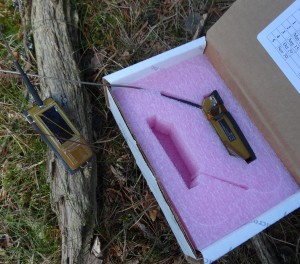Osprey Diary: Satellite Tracking Questions
Q: What is satellite tracking?
It is a modern technology that allows us to temporarily attach small satellite transmitters to a lightweight harness on birds. This gives us information on the birds location, altitude, and behaviour, enabling us to transform our understanding of migration in particular.

Q: How does it work?
The tags are programmed to record the GPS position of the bird and data such as altitude, every hour when possible. It is powered by a small solar panel and battery. The tag then sends this information to the satellite on a preset interval of days-for example, every 2 days during peak migration, and every four days in quieter periods of the year.
Q: Why do it with ospreys?
A: It is an enormously useful scientific research tool in collecting detailed information such as exact routes, timings and behaviours of migrating birds. This work is crucial to more detailed study of the species as they recover and a better understanding of the ‘other half’ of the ospreys’ lives outside the UK.
If we know more about their migratory routes and where they converge at resting points, for example, we can work more closely with organisations and governments in those countries to ensure the areas that ospreys use are protected.
It may also help answer such questions as: Do all UK ospreys take similar routes and have similar destinations? Are any UK Ospreys amongst those now overwintering in southern Europe instead of Africa? Are there countries on route where ospreys have a higher mortality rate? If so, why- is it human causes? Do birds from UK stock migrate to the same locations as their cousins in Scandinavia? Are the birds from the UK more prone to flying off course and ditching in the Atlantic? Are translocated birds following inherited genetic routes that lead them astray?
Lastly, it is fascinating for us all to watch the journeys of these birds and know their individual fates, but this is not the primary reason – merely a by -product of the scientific research that will lead to real results that can help all ospreys in the future.
Q: Has it been done before?
A: This technology has been around for many years but is getting smaller and cheaper all the time. It has been used very successfully on mammals and many birds such as raptors, geese, swans, and now even songbirds such as Cuckoos. Ospreys have been satellite tracked from Speyside , RSPB Loch Garten, Rutland Water Osprey project, the Lake Dsitrict Osprey project , Cors Dyfi in Wales and so on. Also one of our Loch of the Lowes birds Blue 44 was satellite tracked for the first time in 2012, along with a chick from an SWT reserve in Angus Blue YD.
Q: How is the transmitter attached?
A: The tiny transmitter packs are sewn to a lightweight harness which goes around the birds back and wings, like a small rucksack, The harness is sewn together at the front with a few threads – leaving enough room for the chicks to put on weight and allowing the harness to drop off at the end of its useful life. This ensures the harness puts no strain on the bird. There is a small flexible aerial on the top of the pack which receives the satellite signal. Crucially the pack doesn’t interfere with flight or the ospreys’ hunting behaviour, leaving their legs free. See our video on YouTube of the process in action in 2012 at Loch of the Lowes at: http://www.youtube.com/watch?v=C6THdM7FsS4
Q: Does it hurt the bird?
A: No, not at all, as there is no sewing, gluing or other attachment onto the bird and it can move and moult properly. The harness is designed from a super lightweight soft and flexible material that won’t stiffen, chafe or cut into the bird.
Q: Is it heavy for the chick to carry?
A: The tags weigh approximately 5% of the bird’s body weight, approximately 30 grams (as much as a matchbox) This is not thought to significantly impede the birds in their usual movements, or increase chick mortality on migration.
Q: How long will it last?
A: Tags will run on their solar charging units for three to five years. The life of the tags can vary depending on battery life and the amount of data that is to be collected, as well as the conditions that it has to survive in. The bird may also lose its tag before the tag itself gives up, in which case the tag can be retrieved and reused. In most cases, osprey tags last 1-3 years.
Q: How is this research being funded?
A: The Satellite tracking study is being entirely funded by the generous donations and help of many of our members, supporters, volunteers and friends. Thank you to each and every person, club and school class who have contributed, believing as we do , in the scientific value of this research and its long term potential to help ospreys worldwide.
Help protect Scotland’s wildlife
Our work to save Scotland’s wildlife is made possible thanks to the generosity of our members and supporters.
Join today from just £3 a month to help protect the species you love.
Preface
Q: What is satellite tracking? It is a modern technology that allows us to temporarily attach small satellite transmitters to a lightweight harness on birds. This gives us information on …
